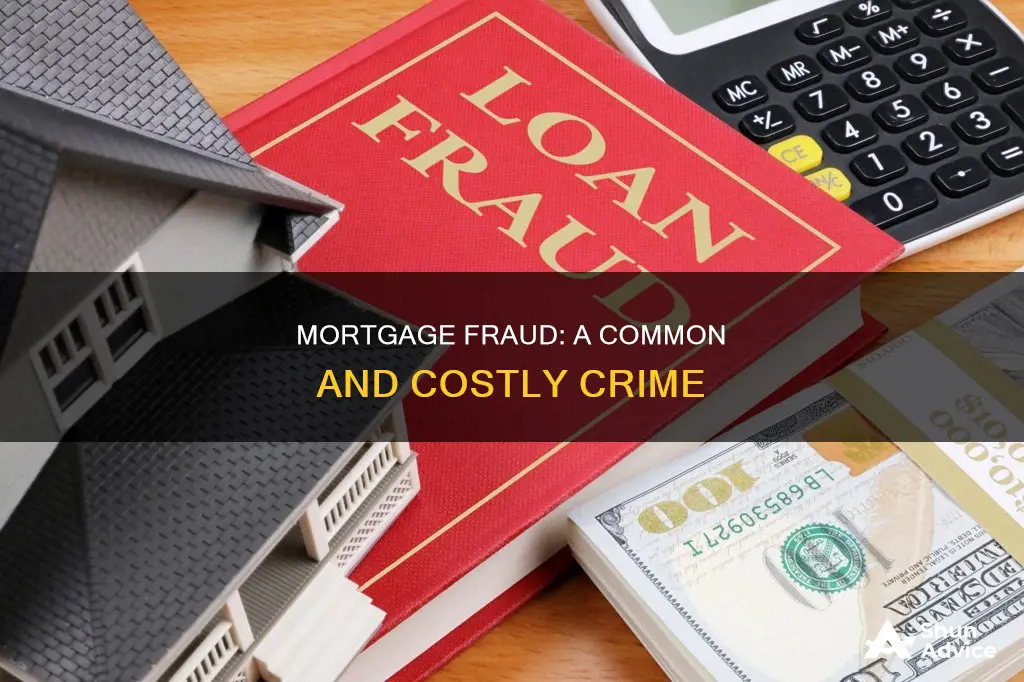
Mortgage fraud is a growing problem, with fraud attempts becoming more frequent and more successful. According to a CoreLogic report, an estimated 0.75% of all mortgage applications—or 1 in 134—contained fraud in the second quarter of 2023. The FBI defines mortgage fraud as a lie that influences a bank's decision, and it falls into two categories: fraud for profit and fraud for housing. Fraud for profit is often committed by people who work in the mortgage industry, such as loan officers, appraisers, or real estate attorneys, while fraud for housing is typically committed by borrowers. With the rise of digital mortgage activity, lenders need to be aware of the evolving types of mortgage fraud and implement advanced monitoring and prevention tools to stay ahead of the fraudsters.
| Characteristics | Values |
|---|---|
| Common types of mortgage fraud | Identity theft, income/asset falsification, appraisal fraud, air loans, occupancy fraud, straw buyer scam, property flipping, wire fraud, bots |
| Common perpetrators of mortgage fraud | Any professional in the loan transaction chain, including the builder, real estate sales agent, loan officer, mortgage broker, credit/debt counsellor, real estate appraiser, property inspector, insurance agent, title company, attorney, and escrow agent |
| Mortgage fraud trends | On the rise, with a reported 8.3% year-over-year increase in the second quarter of 2024; fraud activity is most prevalent in New York, Florida, California, Connecticut, and New Jersey |
| Impact of mortgage fraud | Mortgage lenders lose an average of $5.34 for every dollar lost to real estate scams; the FBI estimates that 80% of all reported fraud losses involve collaboration or collusion by industry insiders |
| Difficulty of detecting mortgage fraud | Hard to detect, especially with the increase in digital mortgage activity and the use of bots; lenders need to implement advanced monitoring and prevention tools to stay ahead of evolving fraud schemes |
| Solutions to mortgage fraud | Advanced monitoring and prevention tools, such as automated fraud detection products and tech-savvy fraud and risk mitigation tools offered by companies like Certified Credit |
What You'll Learn

Mortgage fraud is on the rise
One prevalent type of mortgage fraud is occupancy fraud, where borrowers misrepresent their occupancy status as owner-occupants instead of investors. This allows them to obtain cheaper mortgages, as they claim to be buying properties to live in rather than to flip or rent out. Another common scheme is income fraud, where individuals inflate their income on mortgage applications to qualify for a higher loan amount. This enables them to purchase more expensive properties or acquire lower interest rates and down payments.
Fraudulent activities also extend to property flipping, where a property is purchased, falsely appraised at a higher value, and then quickly sold. This involves doctored loan documentation, inflated buyer income, and even kickbacks to various parties involved in the transaction. Additionally, schemes like equity skimming and air loans exploit straw buyers, false income documents, and non-existent properties to obtain mortgage loans.
The evolving nature of mortgage fraud demands constant vigilance and advanced monitoring tools. Wire fraud, for instance, has seen a significant increase, with hackers impersonating mortgage professionals to trick lenders into wiring them money. Moreover, the rise of digitization has introduced bots as perpetrators of fraud, making detection even more challenging. To combat these issues, lenders must stay informed about emerging trends and implement effective prevention measures.
Monthly Mortgage: How Much Should You Be Spending?
You may want to see also

Fraud for profit vs. fraud for housing
Mortgage fraud is a serious legal offence that involves the deliberate act of lying or omitting information to influence a bank's decision about a mortgage loan. It can be committed by both borrowers and industry professionals, and there are two main types: fraud for profit and fraud for housing.
Fraud for Profit
Fraud for profit is committed by industry professionals who misuse their specialised knowledge or authority to misstate, misrepresent, or omit relevant details about a property or an individual's financial situation. The goal is to maximise profits on a loan transaction, and it often involves collusion between multiple insiders such as bank officers, appraisers, mortgage brokers, attorneys, and loan originators. Fraud for profit schemes frequently include a straw borrower whose credit report is used to obtain an inappropriately large loan, with the proceeds shared between the parties involved. This type of fraud does not aim to secure housing but rather to steal cash and equity from lenders or homeowners.
Fraud for Housing
Fraud for housing, also known as occupancy fraud, is committed by borrowers motivated to acquire or maintain ownership of a house. They may misrepresent or omit relevant details about their employment, income, debt, credit, or property value to obtain a mortgage loan they would not otherwise qualify for. This type of fraud can also involve borrowers working with loan officers or other industry professionals to manipulate a property's appraised value or engage in other illegal actions to obtain or maintain real estate ownership.
The FBI and other law enforcement agencies prioritise investigating and prosecuting mortgage fraud, particularly fraud for profit cases that endanger the stability of the banking system and the safety of assets and personal information. The incidence of mortgage fraud has been rising, with a significant increase in reports and awareness of potential fraud in dynamic real estate markets.
The Mortgage Market: A Giant in the Industry
You may want to see also

Common types of mortgage fraud
Mortgage fraud has been an ongoing concern for lenders, and it has been on the rise in recent years, largely due to the increase in digital mortgage activity. According to the FBI, it costs the US between $1-10 billion per year. There are two primary categories of mortgage fraud: fraud for profit and fraud for housing. Here are some common types of mortgage fraud:
Occupancy Fraud
This occurs when the borrower misrepresents whether a property will be occupied or not. The owner may live elsewhere but claim that the home will be owner-occupied to obtain more favourable terms. Indicating that a home will be occupied allows the buyer to qualify for lower mortgage rates, lower out-of-pocket purchase costs, and higher loan-to-value ratios. Lenders should be cautious of large down payments, appraisals that include expected rent payments, and buyers who live rent-free.
Straw Buyers or Nominee Loans
A "straw buyer" is someone who uses their good credit history and identity to apply for a loan on behalf of the real buyer, who may have bad credit or be trying to conceal information that could disqualify them. The property title is then transferred to the real buyer after the transaction is complete. Funds coming from an institution rather than an individual or a lack of direct interaction between the lender and the buyer can be red flags.
Property Flipping
This involves purchasing a property, falsely appraising it at a higher value, and then quickly reselling it. The appraisal information is fraudulent and may be inflated by a "flipper" acting as a middleman. Other indicators include the property being recently in foreclosure, acquired at a low price, or sold without any renovations.
Wire Fraud
Wire fraud occurs when hackers impersonate mortgage professionals to trick lenders into wiring them money. They use fake email addresses, phone numbers, and bank accounts. The use of digital communication channels has made it easier for criminals to commit wire fraud, and the money is often difficult to recoup.
Income Fraud
Income fraud occurs when the borrower misrepresents their income source or amount, which is required for the loan. This can include false stated income, where the information on the application is not verified, or misrepresentation of employment, where the borrower presents fake proof of employment.
Balloon Mortgages: Are They Common or Uncommon?
You may want to see also

How to identify and prevent fraud
Mortgage fraud is a criminal offence that is investigated and prosecuted by law enforcement. It refers to an intentional misrepresentation of information required to fund, buy, or insure a mortgage. While it can be difficult for lenders to spot, there are several ways to identify and prevent it.
How to Identify Mortgage Fraud
- Be vigilant and aware of common mortgage fraud schemes, such as occupancy fraud, property flipping, and non-arm's length transactions.
- Look out for red flags, such as appraisals that include expected rent payments, buyers living rent-free, large down payments, or inflated property values.
- Conduct thorough background checks on loan officers and employees, including periodic credit checks, to ensure they are not involved in fraudulent activities.
- Utilise software applications that compare borrower information, addresses, employers, and appraisers to detect potential red flags or signs of mortgage fraud.
How to Prevent Mortgage Fraud
- Implement sound internal control measures, including lending fundamentals, quality control procedures, and audit programs.
- Train personnel to identify and report red flags, and establish clear internal reporting procedures.
- Establish a "Know Your Employee" program to conduct background checks and provide ongoing employee oversight and training.
- Report any suspected fraud to the relevant authorities, such as the FHFA's Office of Inspector General, the Consumer Financial Protection Bureau, or the Federal Bureau of Investigation.
- As a borrower, review your application for accuracy, understand the terms of your mortgage, and review your credit report regularly.
Guild Mortgage: A Giant in the Industry
You may want to see also

The cost of mortgage fraud
Mortgage fraud is a costly and concerning issue for lenders, with the cost of fraud rising for both US and Canadian financial services firms. For every $1 lost to fraud, it costs $4.23 to address it, an increase of 16.2% from 2020. This cost covers labour and investigation fees, legal fees, and external recovery expenses. The rise in remote work and digital mortgage activity has made it easier for fraudsters to target mobile channels, with bot attacks and identity fraud on the increase.
Identity fraud is a growing trend, with an approximate 9% increase. This involves the use of false identities and straw buyers to conceal the real borrower and take advantage of their good credit history. The increase in global data breaches has contributed to this, with criminals using the dark web to access information. Lenders are urged to be vigilant and employ more advanced monitoring and prevention tools to detect fraud early on in the application process.
Income fraud is another area of concern, with loan officers and mortgage brokers altering documents to process a mortgage. The rise in remote work has made it more challenging to verify income sources. Property flipping is also a common scheme, where a property is purchased, falsely appraised at a higher value, and then quickly sold. This often involves kickbacks to buyers, investors, property/loan brokers, appraisers, and title company employees.
Rent vs. Mortgage: How Close Should They Be?
You may want to see also
Frequently asked questions
Mortgage fraud is a serious issue, with CoreLogic reporting that as of September 2022, one in every 131 mortgage applications showed indications of fraud. The FBI estimates that 80% of reported fraud losses involve collaboration by industry insiders.
Common types of mortgage fraud include income fraud, occupancy fraud, appraisal fraud, and straw buyer schemes.
Mortgage fraud can be committed by both borrowers and mortgage industry professionals. Fraud for profit is typically committed by industry insiders, while fraud for housing is usually committed by borrowers.
Mortgage fraud is a serious legal offence and can result in criminal and civil penalties, as well as negative impacts on an individual's credit and finances.







